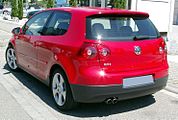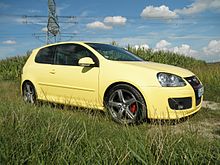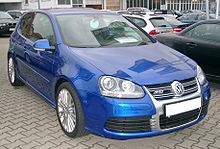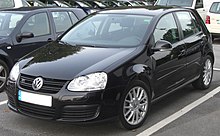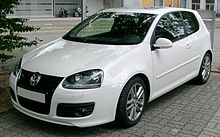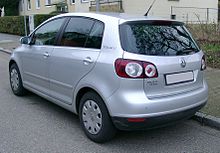VW Golf V
| Volkswagen | |
|---|---|
|
VW Golf Limousine
|
|
| Golf / Rabbit (Type 1K) | |
| Sales designation: | Golf (V) |
| Production period: | 2003-2008 |
| Class : | Compact class |
| Body versions : | Station wagon , station wagon |
| Engines: |
Otto engines : 1.4–3.2 liters (55–184 kW) Diesel engines : 1.9–2.0 liters (55–125 kW) |
| Length: | 4204-4206 mm |
| Width: | 1759 mm |
| Height: | 1470-1483 mm |
| Wheelbase : | 2578 mm |
| Empty weight : | 1155-1590 kg |
| Previous model | VW Golf IV |
| successor | VW Golf VI |
| Stars in the Euro NCAP - Crash Test (2004) |
|
Golf V is the name of the fifth series of the VW Golf . It replaced the successful Golf IV in October 2003 .
In October 2008 the Golf V was replaced by the Golf VI in Germany .
For the first time the Golf V was held has been used since the Golf I simple torsion beam axle with a rear four-link equipped. It has improved handling characteristics, especially in curves. In this way, Volkswagen drew level with Ford, which had been using a similarly elaborate rear axle design in Focus since autumn 1998 . Based on the newly developed rear axle, Volkswagen was able to use the Golf V platform for significantly heavier models such as the VW Touran .
The Golf V was unable to build on the success of its predecessor in Germany, which can be seen, among other things, from the fact that on December 31, 2008 - i.e. at the end of the last year of production - only 786,554 Golf Vs were registered in Germany. At the same time, the registration statistics for the previous model, which had already been out of production for five years, showed almost twice as many vehicles at 1,558,955, while the previous model (Golf III), which had been discontinued for eleven years, still showed 1,137,614. The consequence of the comparatively low sales was a shortened construction time of the Golf V. The successor Golf VI , which had been modified in technical details and outwardly, came out in 2008 earlier than expected. The platform and many components that were not externally visible were the same as in the Golf V.
In the US , the model was known as the VW Rabbit .
Model history
General
- 2003: Presentation of the Golf V with the petrol engines 1.4 55 kW (75 PS), 1.4 FSI 66 kW (90 PS) and 1.6 FSI 85 kW (116 PS) as well as the diesel engines 1.9 TDI 77 kW ( 105 PS) and 2.0 TDI 103 kW (140 PS); new four-link rear axle. Standard (on the German market) were: four disc brakes , electromechanical power steering , electronic stability program (ESP), traction control (ASR), brake assist , electronic differential lock ( EDL), anti-lock braking system (ABS), six airbags , electric exterior mirrors and window lifters and radio central locking . Both the estate version Golf IV Variant and the notchback and also offered as a station wagon Bora were built.
- In the Golf V, as in the Golf IV since 2001, the CAN bus from Bosch was used.
- 2004: Further engines: Otto engines 1.6 75 kW (102 PS) and 2.0 FSI 110 kW (150 PS) as well as diesel engines 2.0 SDI 55 kW (75 PS) and 1.9 TDI 66 kW (90 PS); "30 Years of Golf": free air conditioning ( sales promotion limited until September 2004), 6-speed direct shift gearbox (DSG) as an optional extra for the 1.9 TDI 77 kW (105 PS) and 2.0 TDI 103 kW (140 PS), 6-speed automatic transmission with Tiptronic gearshift as special equipment at an extra charge for the engines 1.6 75 kW (102 PS), 1.6 FSI 85 kW (115 PS) and 2.0 FSI 110 kW (150 PS) , Golf 4motion with all-wheel drive available as special equipment for the 2.0 FSI 110 kW (150 PS), 1.9 TDI 77 kW (105 PS) and 2.0 TDI 103 kW (140 PS) engines.
- 2005: Start of production of the Golf GTI with a newly developed turbocharged FSI engine with 147 kW (200 PS).
- In mid-2005 (model year 2006), some economy measures were implemented, such as a rod antenna (as in the IV) and darker, more pleasant materials on the dashboard, only eight instead of ten speakers, a smaller battery in the 1.4 and 1.6 - Gasoline engine. The changes could be different depending on the equipment variant. The notchback version Jetta came on the market.
- September 2005: The special model 'Golf speed' was introduced. This special edition was a project by VW trainees and was limited to 200 copies. 100 vehicles each were made in yellow and orange (original Lamborghini colors ).
- December 2005: Golf GT with the new TSI Twin Charger as TSI (compressor and turbocharger) and as a 2.0 TDI with 125 kW (170 PS).
- January 2006: Introduction of the Golf GTI in the USA
- February 2006: Golf Goal as a special model for the 2006 World Cup in Germany. The Goal received extensive standard equipment with air conditioning, CD radio, heated seats, parking aid, cruise control, multifunction display, leather steering wheel, floor mats, 16-inch wheels / tires, fog lights, lowering the passenger mirror, heated windscreen washer nozzles and a headlight cleaning system. Compared to the standard Trendline model , this resulted in a price advantage of 1236 euros. VW offered Copper Orange as a special color. Production until August 2006.
- Summer 2006: Launch of the Golf V in North America under the name Rabbit ; Launch of the Golf TSI with 103 kW (140 PS).
- 2007: Special model Golf V "Fahrenheit" - an edition of the GTI with DSG that was only available in the USA (1,200 units) and Canada (150 units).
- January 2007: Special Golf Tour model in cooperation with TUI as the successor to Golf Goal; Slightly changed equipment (voucher for one day of travel when booking through TUI, omission of the winter package and floor mats).
- March 2007: Presentation of the Golf V Variant at the Geneva Motor Show . Market launch in summer 2007.
- July 2007: 1.4 TSI with 90 kW (122 PS) replaced 1.6 FSI.
- October 2007: Special model Golf United as the successor to the Golf Tour with slightly different equipment ( standard Mugello alloy wheels , sports bag with towel and ball from Nike, no Climatronic and other items). For the first time, the 90 kW TSI can be ordered with a 7-speed direct shift gearbox.
- February 2008: Special model Golf Edition parallel to Golf United with less equipment (standard light alloy wheels Atlanta , Climatic, chrome package, but no sports bag-towel-ball from Nike, light-and-sight package, winter package, tinted windows and others ).
- Summer 2008: End of the customization of the Golf V ex works due to the upcoming model change in October.
Golf GTI
The Golf V GTI came onto the market in autumn 2004. It was characterized by optical features, such as a different radiator grille, a so-called badge grille (a special form of the Singleframe used at Audi) with a red border, black side skirts, BBS hollow-chamber wheels in 17 or 18 inches, checkered seat covers, aluminum inserts and others Speedometer. Technical adjustments were, for example, the GTI sports suspension or the 2.0 TFSI four-cylinder petrol engine with an output of 147 kW (200 hp).
Golf GTI "Edition 30"
To mark the 30th anniversary of the Golf GTI, Volkswagen presented the front-wheel drive GTI special edition Edition 30 in autumn 2006 . The special model differed
- Externally by add-on parts painted in the vehicle color and slightly modified compared to the normal GTI, dark taillights, black aluminum wheels Detroit and Edition 30 lettering on the rear,
- with a modified interior: red decorative stitching on the handbrake lever, steering wheel, floor mats and golf ball gear knob as well as sports seats with checkered covers, edged in leather-covered side panels.
In allusion to the 30th birthday of the Golf GTI, this special model has a 30 HP engine with 169 kW (230 HP) and 300 Nm. The vehicle can reach a top speed of 245 km / h (factory specification). The Golf GTI accelerates from zero to 100 km / h in 6.8 seconds (manual transmission) or 6.4 seconds (direct shift transmission). Turbocharger and short engine were also used in the Audi S3 (195 kW / 265 PS).
Golf GTI Pirelli
In September 2007, Volkswagen released a new GTI model for sale: the Golf GTI Pirelli .
Equipped with the engine of the Golf GTI Edition 30 and many extras, such as special Pirelli wheels, darkened rear lights, bumpers painted in the vehicle color, side skirts and partial leather sports seats with an embossed tire profile and yellow decorative stitching, the Pirelli GTI was reminiscent of the 1983 introduced Golf I GTI Pirelli . The special yellow shade "Sunflower" was only available for the Pirelli edition.
Golf GTI "Limited Edition 240"
In 2008, Volkswagen presented the GTI Limited Edition 240, a special model of the Golf GTI based on the GTI Edition 30. It was equipped with a 2.0-liter TFSI engine, which had an output of 176 kW (240 PS), around 10 PS more than the Edition 30 GTI. This model was also equipped with bi-xenon headlights, a Pioneer touchscreen navigation system, a new sound system and the "Limited Edition 240" emblem on the front grille and rear. The special model, of which only 300 were built, was only available in the Netherlands .
Golf SDI
The designation SDI (suction diesel with direct injection) stands for a diesel engine that is largely identical to the TDI, except for the missing turbocharger including charge air cooling and a correspondingly simplified engine control. The output was 50 kW (68 hp) with a displacement of 1.9 liters. An SDI with two liters of displacement, a maximum output of 55 kW (75 PS) and 140 Newton meters of maximum torque was available in the Golf V since February 2004. In this engine, the pump-nozzle direct injection familiar from the TDI was used for the first time . The Golf 2.0 SDI reaches a top speed of 163 km / h.
Golf BlueMotion
After the BlueMotion models from Polo and Passat, Volkswagen presented a fuel-efficient variant of the Golf V at the 2007 IAA. With its TDI engine with 77 kW (105 PS) it achieved an average consumption of 4.5 liters according to the factory. The savings compared to the standard Golf with the same engine are 0.6 liters, about twelve percent. The surcharge for the BlueMotion package was 315 euros and included a slight lowering, aerodynamic improvements (covering the underbody), smooth-running tires and an on-board computer with recommended gear selection. In contrast to the manual gearbox of the standard Golf variants with six gears, the Golf V BlueMotion received a five-speed manual gearbox with a longer gear ratio. The top speed was 190 km / h.
Golf R32
The Golf R32 based on the Golf V was available from September 2005.
The R32 was the last model in the series with a six-cylinder. The 184 kW (250 PS) and 320 Nm torque of the newer VR6 engine were - as in the Golf IV R32 - transferred to the road by the 4MOTION all-wheel drive. A manually shifted six-speed gearbox was standard, the direct shift gearbox DSG was offered as an option. The top speed was 250 km / h. From a standing start, the R32 took 6.5 seconds to 100 km / h (with DSG : 6.2 seconds).
Even in the basic version, this Golf was equipped with numerous functions such as automatic air conditioning (Climatronic), on-board computer , ABS (anti-lock braking system), ESP (electronic stability program), xenon light , brake assist and front 345 mm brake discs. The standard equipment of the R32 increased its curb weight; At 1590 kg, it was almost 450 kg higher than the basic equipment of the Golf V. In the Golf VI and VII, the top R models are each powered by a turbocharged four-cylinder.
Golf GT / GT Sport
The Golf GT / GT Sport with TSI technology was presented in February 2006. The engine was charged by both a turbocharger and a compressor (double or stage charging ). The compressor works alone in the lower speed range, while the turbocharger is “switched on” in the middle range. At high speeds, the turbo works alone. As a result, he achieved a maximum torque of 240 Nm and a top speed of 220 km / h. This technology was already used in 1985 in the Lancia Delta S4 .
The Golf GT / GT Sport was also available with a 2.0 TDI engine that developed a maximum of 125 kW (170 hp) at 350 Nm. The diesel GT / GT Sport had a standard consumption mix of 5.9 liters of diesel per 100 kilometers, accelerated from 0 to 100 km / h in 8.2 seconds and reached a top speed of 220 km / h.
Difference between Golf GT and GT Sport
The GT Sport replaced the equipment and design lines GT and Sportline, so that the visually differentiated GT appearance could now also be combined with more engines.
Outwardly, the differences between the two models were relatively small. For example, the radiator grille rim on the new model was painted in black and not in the same color as the car, and the lower front apron was designed slightly differently. At the rear, the GT Sport had a completely painted apron, but not the always visible twin tailpipe (only with 125 kW). As a result, the new variant optically corresponded to the equipment of the Volkswagen Individual design package available from Trendline and Comfortline. After all, there were different aluminum wheels than on the GT; the 17-inch format and the 225/45 tires remained unchanged.
The GT Sport was - like the GT up to that point - in particular equipped with a sports suspension, automatic air conditioning, sports seats in the front, leather on the steering wheel, gear knob and handbrake handle and a multifunction display. Compared to the GT, fog lights were added and in particular the electric sliding glass or tilting roof (only on the German model), as is also included in the special 'Tour Edition' model. The windows, which were darkened from the B-pillar, were also new and standard. In contrast to the previous versions, the GT Sport no longer had a trailer hitch available.
The Golf GT Sport could be equipped with further R-Line packages.
Five gasoline and three diesel engines were available for the GT Sport, all but the 59 kW gasoline engine and the GTI and R32 drives. Variants with all-wheel drive were also available.
Golf Plus
→ Main article: VW Golf Plus
The Golf V was also offered as a plus version with more space and a raised roof (length / width / height: 4206/1759/1580 mm). The mini-van variant of the Golf has, among other things, a significantly higher seating position and more legroom for the rear passengers. Since the seats are installed in an elevated position, the headroom is not higher than in the normal version. With plenty of storage space and a larger luggage compartment than the standard Golf (505/1450 l), the Golf Plus is intended for families with children.
From February 2006 to the end of 2006, the Golf Plus was available in the Goal special edition . From the beginning of 2007 the special edition Tour was available in cooperation with the tour operator Tui.
CrossGolf
The VW CrossGolf is based on the Golf Plus.
Golf Variant
→ Main article: VW Golf Variant
Volkswagen initially wanted to use the Golf Plus as the successor to the Golf IV Variant , but then presented the new station wagon version based on the VW Jetta at the Geneva Motor Show in March 2007 . With this, the Variant was structurally identical up to the A-pillar and at 4.56 meters also long. At the rear, the taillights were integrated into the fenders, but did not reach into the luggage compartment like on the hatchback. The license plate was below the smaller VW emblem. The trunk held 505 to 1550 liters. The three equipment lines could be combined with six engines (five since summer 2008): as a gasoline engine, the 1.6-liter engine with 75 kW (102 hp), the 1.4-liter TSI engine with 90 kW (122 hp) , 103 kW (140 PS) or 125 kW (170 PS) and as diesel with the two TDI engines with 77 kW (105 PS) or 103 kW (140 PS). The two 140 and 170 PS 1.4 TSI engines were replaced in summer 2008 (model year 2009) by the 1.4 TSI with 118 kW (160 PS). Prices started at 18,875 euros.
From the beginning of November 2007 the Variant was also available in all equipment variants as BlueMotion ; In contrast to the production model, the underbody was covered and the body lowered by 15 millimeters. The standard consumption of the BlueMotion variant was 4.6 liters per 100 kilometers, whereby, as with the sedan, only the 1.9-liter TDI engine (77 kW / 105 PS) was used. As with all BlueMotion models, there was an on-board computer with recommended gear selection and a transmission with a significantly longer ratio in third to fifth gear.
In May 2009 the Variant was revised and the front of the Golf VI was adapted.
Studies
Golf R GTI
The Golf R GTI was presented at the SEMA 2006 show in the United States. This car was designed together with the US design team from Volkswagen and the American tuner APR. They also continued the “R” concept. The car had the 2.0 TFSI standard engine which, thanks to the larger turbocharger and extensive other modifications, developed 279 kW (380 hp). With 100-octane gasoline, an increase to just over 400 hp was possible. The Golf R GTI accelerated from 0 to 100 km / h in 4.4 seconds. The speed limit was 250 km / h. The Golf was weight-optimized: There were many parts made of carbon fiber reinforced plastic and instead of a back seat, there were two bucket seats. The Golf R GTI was no longer a concept vehicle, but it was also never produced in series.
Golf GTI W12 650
Volkswagen developed the GTI W12 650 study on the occasion of the GTI meeting in Reifnitz am Wörthersee in 2007 . The body was widened by twelve centimeters and lowered by eight centimeters. The study stood on 19-inch wheels in the design of the Golf V GTI. The 6.0-liter twin-turbo W12 engine was installed in front of the rear axle. It developed 478 kW (650 hp), had a torque of 750 Newton meters and accelerated the vehicle from 0-100 km / h in 3.7 seconds. The top speed was 325 km / h.
Technical specifications
Otto engines 2003–2008
| 1.4 | 1.4 FSI | 1.4 TS I | 1.4 T SI | 1.6 | 1.6 FSI | 2.0 FSI | 2.5 | |||
|---|---|---|---|---|---|---|---|---|---|---|
| Construction period | 10 / 2003-06 / 2006 | 05/2006–11/2008 | 10 / 2003-07 / 2006 | 07/2007–11/2008 | 05/2006–11/2008 | 11/2005–11/2008 | 01 / 2004–11 / 2008 | 10 / 2003-07 / 2007 | 02 / 2004–11 / 2008 | 2006-2008 |
| Engine characteristics | ||||||||||
| Engine code | BCA | BUD | BKG, BLN | CAXA | BMY | BLG | BGU, BSE, BSF |
BAG, BLF, BLP |
AXW, BLR, BLX, BLY, BVY, BVZ, BVX, BMB |
BGQ |
| Engine type | R4 petrol engine | R5 petrol engine | ||||||||
| Number of valves per cylinder | 4th | 2 | 4th | |||||||
| Valve control | DOHC , timing belt | DOHC, chain | OHC, timing belt | DOHC, chain | DOHC, timing belt | DOHC, chain | ||||
| Mixture preparation | Manifold injection | Direct petrol injection | Manifold injection | Direct petrol injection | Manifold injection | |||||
| Engine charging | - |
Turbocharger , intercooler |
Turbocharger, intercooler, compressor |
- | ||||||
| cooling | Water cooling | |||||||||
| Bore × stroke | 76.5 x 75.6 mm | 81.0 x 77.4 mm | 76.5 x 86.9 mm | 82.5 x 92.8 mm | ||||||
| Displacement | 1390 cm³ | 1595 cc | 1598 cc | 1984 cc | 2480 cc | |||||
| Compression ratio | 10.5: 1 | 12.0: 1 | 10.0: 1 | 10.5: 1 | 12.0: 1 | 11.5: 1 | k. A. | |||
| Max. power | 55 kW (75 PS) at 5000 rpm |
59 kW (80 PS) at 5000 rpm |
66 kW (90 PS) at 5200 rpm |
90 kW (122 PS) at 5000 rpm |
103 kW (140 PS) at 5600 rpm |
125 kW (170 PS) at 6000 rpm |
75 kW (102 PS) at 5600 rpm |
85 kW (115 PS) at 6000 rpm |
110 kW (150 PS) at 6000 rpm |
125 kW (170 PS) at 5700 rpm |
| Max. Torque | 126 Nm at 3800 rpm |
132 Nm at 3800 rpm |
130 Nm at 3750 rpm |
200 Nm at 1500-4000 rpm |
220 Nm at 1500-4000 rpm |
240 Nm at 1750-4500 rpm |
148 Nm at 3800 rpm |
155 Nm at 4000 rpm |
200 Nm at 3500 rpm |
240 Nm at 4250 rpm |
| Power transmission | ||||||||||
| Drive, as standard | Front wheel drive | |||||||||
| Drive, optional | - |
All-wheel drive ( 4Motion ) |
- | |||||||
| Gearbox, as standard | 5-speed manual transmission | 6-speed manual transmission | 5-speed manual transmission | 6-speed manual transmission | 5-speed manual transmission | |||||
| Gearbox, optional | - | 7-speed DSG | 6-speed DSG | 6-stage Tiptronic | 6- speed automatic transmission | |||||
| Readings | ||||||||||
| Top speed | 164 km / h | 168 km / h | 174 km / h | 197 km / h with DSG : 195 km / h |
205 km / h with DSG : 203 km / h |
220 km / h with DSG : 218 km / h |
184 km / h with Tiptronic : 181 km / h |
192 km / h with Tiptronic : 189 km / h |
209 km / h with Tiptronic : 205 km / h with 4Motion : 207 km / h |
209 km / h |
| Acceleration, 0-100 km / h | 14.7 s | 13.9 s | 12.9 s | 9.4 s | 8.8 s | 7.9 s with DSG : 7.7 s |
11.4 s with Tiptronic : 12.5 s |
10.8 s with Tiptronic : 11.5 s |
8.9 s with Tiptronic : 9.5 s with 4Motion : 9.2 s |
k. A. |
| Fuel consumption over 100 km (combined) | 6.8 l S | 6.9 l p | 6.2 l p | 6.3 l S with DSG : 5.9 l S |
7.1 l p | 7.3 l SP with DSG : 7.3 l S |
7.4 l S with Tiptronic : 8.2 l S |
6.4 l S with Tiptronic : 7.2 l S |
8.0 l SP with Tiptronic : 7.3 l SP with 4Motion : 8.6 l SP |
k. A. |
| CO 2 emissions (combined) | 163 g / km | 165 g / km | 149 g / km | 149 g / km with DSG : 139 g / km |
169 g / km | 174 g / km | 176 g / km with Tiptronic : 195 g / km |
154 g / km with Tiptronic : 173 g / km |
191 g / km with Tiptronic : 197 g / km with 4Motion : 205 g / km |
k. A. |
| Remarks | ||||||||||
| BKG to KW 45/2004 not E10 -verträglich | BAG not E10-compatible until week 22/2004 | AXW up to week 22/2004 not E10 compatible | ||||||||
Petrol engines VW Golf GTI and R32 2003–2008
| 2.0 TFSI GTI | 2.0 TFSI GTI Edition 30 | 2.0 TFSI GTI Limited Edition 240 1 | 3.2 R32 | |
|---|---|---|---|---|
| Construction period | 09 / 2004-06 / 2008 | 11 / 2006-06 / 2008 | 2008 | 08/2005-06/2008 |
| Engine characteristics | ||||
| Engine identification | AXX, BWA, BPY, CAWB |
BYD | k. A. | BDB, BMJ, BUB, CBRA |
| Engine type | R4 petrol engine | VR6 petrol engine | ||
| Number of valves per cylinder | 4th | |||
| Valve control | DOHC , timing belt + chain | DOHC, chain | ||
| Mixture preparation | Direct petrol injection | Manifold injection | ||
| Engine charging |
Turbocharger , intercooler |
- | ||
| cooling | Water cooling | |||
| Bore × stroke | 82.5 x 92.8 mm | 84.0 x 95.9 mm | ||
| Displacement | 1984 cc | 3189 cm³ | ||
| Compression ratio | 10.3: 1 | 10.9: 1 | ||
| Max. power | 147 kW (200 hp) at 5100-6000 rpm |
169 kW (230 PS) at 5500 rpm |
176 kW (240 PS) at 6000 rpm |
184 kW (250 PS) at 6300 rpm |
| Max. Torque | 280 Nm at 1800-5000 rpm |
300 Nm at 2200-5200 rpm |
330 Nm at 2100 rpm |
320 Nm at 2500-3000 rpm |
| Power transmission | ||||
| drive | Front wheel drive |
All-wheel drive ( 4Motion ) |
||
| Gearbox, as standard | 6-speed manual transmission | |||
| Gearbox, optional | 6-speed DSG | |||
| Readings | ||||
| Top speed | 235 km / h with DSG : 233 km / h |
245 km / h with DSG : 243 km / h |
241 km / h with DSG : 240 km / h |
250 km / h with DSG : 248 km / h |
| Acceleration, 0-100 km / h | 7.2 s with DSG : 6.9 s |
6.8 s with DSG : 6.6 s |
6.7 s with DSG : 6.3 s |
6.5 s with DSG : 6.2 s |
| Fuel consumption over 100 km (combined) | 8.0 l SP with DSG : 7.9 l SP |
8.2 l SP with DSG : 7.9 l SP |
8.0 l SP with DSG : 7.9 l SP |
10.7 l SP with DSG : 9.7 l SP |
| CO 2 emissions (combined) | 189 g / km with DSG : 188 g / km |
194 g / km with DSG : 188 g / km |
189 g / km with DSG : 188 g / km |
255 g / km with DSG : 231 g / km |
Diesel engines 2003-2008
| 2.0 SDI | 1.9 TDI | 1.9 TDI DPF | 1.9 TDI DPF BlueMotion | 2.0 TDI | 2.0 TDI DPF | 2.0 TD I DPF | |||
|---|---|---|---|---|---|---|---|---|---|
| Construction period | 01 / 2004-06 / 2008 | 03 / 2004-10 / 2008 | 10 / 2003-10 / 2008 | 06/2005–10/2008 | 11/2007–10/2008 | 10 / 2003-10 / 2008 | 12 / 2004-10 / 2008 | 11/2005–11/2008 | |
| Engine characteristics | |||||||||
| Motor series | VW EA188 | ||||||||
| Engine code | BDK | BRU, BXF, BXJ |
BJB, BKC, BXE |
BLS | AZV | BKD | BMM | BMN | |
| Engine type | R4 diesel engine | ||||||||
| Number of valves per cylinder | 2 | 4th | 2 | 4th | |||||
| Valve control | OHC , timing belt | DOHC, timing belt | OHC, timing belt | DOHC, timing belt | |||||
| Mixture preparation | Pump-nozzle system | ||||||||
| Engine charging | - |
Turbocharger , intercooler |
|||||||
| cooling | Water cooling | ||||||||
| Bore × stroke | 81.0 x 95.5 mm | 79.5 x 95.5 mm | 81.0 x 95.5 mm | ||||||
| Displacement | 1968 cc | 1896 cc | 1968 cc | ||||||
| Compression ratio | 19.0: 1 | 18.0: 1 | |||||||
| Max. power | 55 kW (75 PS) at 4200 rpm |
66 kW (90 PS) at 3750 rpm |
77 kW (105 PS) at 4000 rpm |
100 kW (136 hp) at 4000 rpm |
103 kW (140 PS) at 4000 rpm |
125 kW (170 hp) at 4200 rpm |
|||
| Max. Torque | 140 Nm at 2200-2400 rpm |
210 Nm at 1800-2500 rpm |
250 Nm at 1900 rpm |
320 Nm at 1750-2500 rpm |
320 Nm at 1800-2500 rpm |
350 Nm at 1750-2500 rpm |
|||
| Power transmission | |||||||||
| Drive, as standard | Front wheel drive | ||||||||
| Drive, optional | - |
All-wheel drive ( 4Motion ) |
- | All-wheel drive (4Motion) |
- | ||||
| Gearbox, as standard | 5-speed manual transmission | 6-speed manual transmission | |||||||
| Gearbox, optional | - | 6-speed manual transmission | - | 6-speed DSG | |||||
| 6-speed DSG | |||||||||
| 7-speed DSG | |||||||||
| Readings | |||||||||
| Top speed | 163 km / h | 176 km / h | 187 km / h with DSG : 185 km / h with 4Motion : 185 km / h |
190 km / h | 203 km / h with DSG : 200 km / h |
205 km / h with DSG : 203 km / h with 4Motion : 203 km / h |
220 km / h with DSG : 218 km / h |
||
| Acceleration, 0-100 km / h | 16.7 s | 12.9 s | 11.3 s with 6-speed : 11.1 s with DSG : 11.2 s with 4Motion : 12.1 s |
11.3 s | 9.4 s | 9.3 s with 4Motion : 9.5 s |
8.2 s | ||
| Fuel consumption over 100 km (combined) | 5.4 l D | 5.0 l D | 5.0 l D with 6-speed : 5.4 l D with DSG : 5.8 l D with 4Motion : 6.0 l D |
5.1 l D with 6-speed : 5.5 l D with 4Motion : 6.0 l D |
4.5 l D | 5.3 l D with DSG : 6.0 l D |
5.5 l D with DSG : 6.0 l D with 4Motion : 5.9 l D |
5.5 l D with DSG : 6.0 l D with 4Motion : 6.2 l D |
5.9 l D with DSG : 6.4 l D |
| CO 2 emissions (combined) | 143 g / km | 132 g / km with DPF : 135 g / km |
132 g / km with 6-speed : 143 g / km with DSG : 153 g / km with 4Motion : 158 g / km |
135 g / km with 6-speed : 145 g / km with 4Motion : 158 g / km |
119 g / km | 140 g / km with DSG : 159 g / km |
145 g / km with DSG : 159 g / km with 4Motion : 156 g / km |
145 g / km with DSG : 159 g / km with 4Motion : 164 g / km |
156 g / km with DSG : 169 g / km |
|
|||||||||
Paint colors
The Golf V was available in various standard paint variants as well as special paint variants. All available lacquer variants are listed below:
yellow
- Sunflower LB1B (Pirelli)
- Giallo Midas L0G1B8 (Speed Edition)
- Gorse yellow 9161
orange
- Arancio Boreal Metallic L0E2 (Speed Edition)
- Copper Orange Metallic LA2W (special model "GOAL")
red
- Sunset Red Metallic LA3X
- Colarot 2000 LP3K
- Tornado red LY3D
- Flash red LP3G
Red-violet
- Dark Burgundy pearl effect LC3U
violet
- Violet touch, pearl effect 9074
- Dark violet pearl effect 9968
Blue-violet
- Pearl blue LA5G
- Laser blue pearl effect LC5J
- Shadowblue Metallic LD5Q
blue
- Costal blue pearl effect metallic C5G
- Silver blue metallic LB5S
- Light blue L535
- New Riverblue Metallic LA5S
- Blue L59Q
- Techno blue Perleffek LW5Y
- Mercato blue metallic LA5M
- Ultramarine blue L633
- Ravenna blue metallic LA5W
- Inkyblue pearl effect LC5X
- Deep blue pearl effect LB5R
- Bluegraphite pearl effect LC5F
- Moonlight Blue pearl effect LC5M
- Olympic blue pearl effect LA5K (special model "TOUR")
Blue-green-turquoise
- Bluespirit pearl effect 9958
green
- Cosmic green metallic LA6P
- Sagegreen metallic LA6Q
- Fresco green metallic LA6W
- Bright green pearl effect LC6M
- Greencollection pearl effect LC6W
- Racing green LK6U
- Mint green 9680
- Reseda green 9623
silver
- Reflex silver metallic LA7W
White
- Candy white LB9A B4
Gray
- Silver gray metallic 9072
- Unitedgrey Metallic LA7T
- Pewter gray metallic LA7Y
- Platinium gray metallic LD7X
- Urbangrey Metallic LD7W
black
- Plain black L041
- Black Magic perleffect LC9Z
consumption
The smallest gasoline engine with 59 kW (80 PS) consumes 8.5 liters in urban areas, 5.1 liters in urban areas and 6.4 liters combined per 100 km with an unladen weight of 1142 kilograms.
Logos of the Golf V special models
literature
- The new Golf. Special edition by ATZ and MTZ , Wiesbaden, October 2003
- Automobil Revue , catalog 2007
- VW Golf V logbook, booklet 3.3 Tekniske data , Danish 09.2003
- List of VW engines on vag-codes.info (English)
Web links
- Former official website ( Memento of October 11, 2006 in the Internet Archive )
Individual evidence
- ↑ The Golf V in the crash test (accessed on September 4, 2014, English)
- ↑ Focus: Driving report VW Golf V
- ↑ VW Golf IV Diesel in a compact class comparison: Driving comfort ( Memento of the original from December 16, 2013 in the Internet Archive ) Info: The archive link was inserted automatically and has not yet been checked. Please check the original and archive link according to the instructions and then remove this notice. (Note: In the headline there is talk of the Golf IV, but a Golf V was rated)
- ↑ www.kba.de/Statistik 2008, page 41 (PDF file; 2.7 MB) ( Memento from April 17, 2012 in the Internet Archive )
- ↑ Please explain: Golf BlueMotion vs. 6-speed: VW Golf , accessed September 4, 2014
- ↑ VW Golf BlueMotion: 4.5 liter consumption - Archive ( Memento of the original from September 27, 2007 in the Internet Archive ) Info: The archive link was inserted automatically and has not yet been checked. Please check the original and archive link according to the instructions and then remove this notice. , accessed September 4, 2014
- ↑ a b c List of Volkswagen car models that are not suitable for the E-10 ( Memento of the original from February 25, 2015 in the Internet Archive ) Info: The archive link has been inserted automatically and has not yet been checked. Please check the original and archive link according to the instructions and then remove this notice. (PDF; 12 kB)



